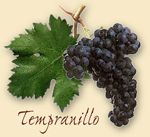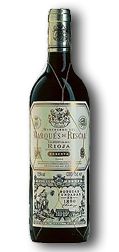 |
 Tempranillo,
Spain’s Noble Grape Tempranillo,
Spain’s Noble Grape
Tempranillo is Spain’s quintessential, indigenous “Noble
Grape”. Jancis Robinson says in the “Oxford Companion
to Wine”, that it is “Spain’s answer to Cabernet
Sauvignon, while John Radford writes in his wonderful “The
New Spain” Spanish wine guide, that “research indicates
a possible common ancestor with Pinot Noir.” What the
experts do agree on, however, is that it is a “classic” quality
grape variety, and responsible for making some of Spain’s
Best wines. It’s a thick-skinned black grape used to
make full-bodied red wines. Tempranillo responds sublimely
to delicate integration of American and French oak, producing
deep colored smooth, elegant wines capable of long aging, with
sensuous notes of vanilla, cedar and soft spice. It is also
ideal for making young wines, “jovenes”, where
the grape imparts juicy strawberry and summer fruits flavours.
The term “Tempranillo” is named after the Spanish
word “Temprano”, for “early”, referring
to the fact that this grape ripens sooner than the other traditional
varietals in Spain (2 weeks earlier than Garnacha, for example).
 It’s most famous expression is in the rich, velvety
red wines of La Rioja, where it is mostly blended with Garnacha
Tinta, Mazuelo and Graciano and aged in oak barricas. For some
expensive and sophisticated modern Riojas, it is being blended
with Cabernet Sauvignon. However, as Cabernet Sauvignon is
prohibited in the Appellation (The DOc), it can’t be
mentioned on the bottle label. In Navarra, where such restrictions
don’t apply, it is enthusiastically and eloquently blended
with Merlot and Cabernet Sauvignon. Excellent examples include
Guelbenzu’s “Lautus Crianza” which is comprised
of 50% Tempranillo, 30% Merlot, 10% Cab Sauv, 10% Garnacha,
and aged for12 months in French oak. It’s most famous expression is in the rich, velvety
red wines of La Rioja, where it is mostly blended with Garnacha
Tinta, Mazuelo and Graciano and aged in oak barricas. For some
expensive and sophisticated modern Riojas, it is being blended
with Cabernet Sauvignon. However, as Cabernet Sauvignon is
prohibited in the Appellation (The DOc), it can’t be
mentioned on the bottle label. In Navarra, where such restrictions
don’t apply, it is enthusiastically and eloquently blended
with Merlot and Cabernet Sauvignon. Excellent examples include
Guelbenzu’s “Lautus Crianza” which is comprised
of 50% Tempranillo, 30% Merlot, 10% Cab Sauv, 10% Garnacha,
and aged for12 months in French oak.
Unlike other classic grape varieties, like Merlot or Cabernet
Sauvignon, Tempranillo has a bewildering array of aliases around
Spain’s wine regions. In La Rioja, Navarra, Somontano
(in the Pyrenees) and the Levante (south eastern Murcia and
Valencia), it is known by its international name, “Tempranillo”.
However, it is also called “Cencibel” in La Mancha
and Valdepeñas (south of Madrid); “Ull de Llebre” (eye
of the hare) in Catalonia; “Tinta de País” or “Tinto
Fino” in Ribera del Duero; “Tinta de Toro” in
Toro; and completely lacking in imagination, it is called Tinto
de Madrid”
for…you guess. Tempranillo is used in quality winemaking
outside Spain, in Portugal (where it is known as Tinta Roriz
in the Douro, and is a principal component of Port and as “Aragonêz” in
the Alentejo region east of Lisbon) and extensively in Argentina
and Mexico. Finally, just to add more confusion, Tempranillo
is grown in California by wineries for grape juice, and is
called Valdepeñas!
The names of grape varieties have, until recently, never featured
prominently on Spanish wine bottles. As in France, where the
bottle of Sancerre does not say “Sauvignon Blanc”,
the names of the varietals were not of great interest to the
consumer. However, as wine consumers have become more knowledgeable
about what wines they like, the indication of grape variety
has increased in commercial importance. With the onslaught
of excellent quality, value for money, single and multi varietal
branded wines from the “new world” (mainly Australia,
Chile and California), the “old world” seems to
have taken the attitude “if you can’t beat ‘em,
join ‘em”. You can now readily find Spanish wine
bottles labelled “Chardonnay, Tempranillo, etc” (particularly
from progressive Navarra and Catalonia).
Try these wonderful examples of Tempranillo:
 Marqués
de Riscal, Reserva, 1998, Doc La Rioja: Classic
Rioja from the most classic bodega of them all, Riscal, founded
in 1860. No surprises here, consistent quality, frankly too
easy to drink! Made from 90% Tempranillo and 10% Graciano and
Mazuelo. 24 months in oak and extended period in bottle, result
in a soft yet complex wine, which is equally nice either with
food or on its own. Marqués
de Riscal, Reserva, 1998, Doc La Rioja: Classic
Rioja from the most classic bodega of them all, Riscal, founded
in 1860. No surprises here, consistent quality, frankly too
easy to drink! Made from 90% Tempranillo and 10% Graciano and
Mazuelo. 24 months in oak and extended period in bottle, result
in a soft yet complex wine, which is equally nice either with
food or on its own.
Finca
Antigua, Tempranillo, 2001, DO La Mancha: New wave wine,
made in a very “new world” style (and branding)
by the famed Martinez Bujanda family of La Rioja (Conde de
Valdemar, Finca Valpiedra) in a stunning new winery. This winery
is causing a colossal change in the region of La Mancha, which
has always been known for being a wine region of quantity (bulk),
rather than quality. The Bujanda family have invested millions
on this new venture and the results are starting to pay off.
This Tempranillo is lovely, soft, with strawberries on the
nose, and luscious on the palate. Made with 100% Tempranillo
from 15 year old vines with 6 months in new American oak.
Related links
Cellar Tours - Unforgettable
wine tours through some of the most charming, untouched wine
regions
in the world.
Cellar
Tastings - Detailed information on gourmet and culinary
activities, wine and winery information, food and wine tours
and other forms of unique travel for the Gourmand, and various
fun and educational events related to the world of food and
wine. |
 |




